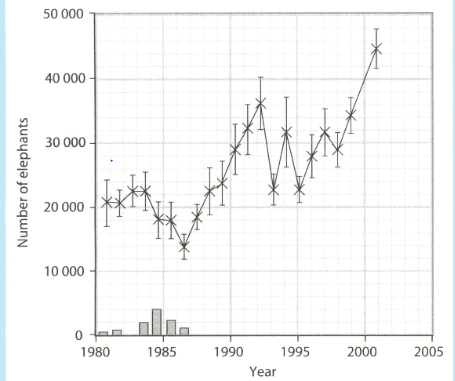Mary Jones, Richard Fosbery, Dennis Taylor and, Jennifer Gregory Solutions for Chapter: Classification Biodiversity and Conversation, Exercise 20: EXAM-STYLE QUESTIONS
Mary Jones Biology Solutions for Exercise - Mary Jones, Richard Fosbery, Dennis Taylor and, Jennifer Gregory Solutions for Chapter: Classification Biodiversity and Conversation, Exercise 20: EXAM-STYLE QUESTIONS
Attempt the practice questions on Chapter 18: Classification Biodiversity and Conversation, Exercise 20: EXAM-STYLE QUESTIONS with hints and solutions to strengthen your understanding. Biology for Cambridge International AS & A Level coursebook 2nd Edition Digital Access solutions are prepared by Experienced Embibe Experts.
Questions from Mary Jones, Richard Fosbery, Dennis Taylor and, Jennifer Gregory Solutions for Chapter: Classification Biodiversity and Conversation, Exercise 20: EXAM-STYLE QUESTIONS with Hints & Solutions
The number of elephants in Hwange National Park in Zimbabwe were counted each year between 1980 and 2001. In the 1980’s some of the elephants were culled. This practice stopped in 1986. The graph shows the changes in the numbers of elephants the bars indicate the number of elephants that were culled.

Describe the changes in the numbers of the elephants between 1980 to 2001.
Elephants feed by browsing on woody vegetation and other plants. They strip bark from the trees and push over some trees, keeping patches of grassland open but leaving much woodland.
Explain how both the high and low densities of elephants could result in reduced species diversity in national parks in Africa.
Explain the reasons for culling animals such as elephants in national parks other than to prevent the loss of biodiversity.
There are many seed banks in different parts of the world. Explain the reasons for depositing samples of seeds in cold storage.
Explain what is meant by the term frozen zoo.
Explain how captive breeding animals such as Przewalski’s horse, can help to conserve an endangered species.
Exaplain how genetic diversity is maintained during a captive breeding programme.
Suggest how the success of a scheme to reintroduce a species of mammal such as Przewalski’s horse, may be assessed.
